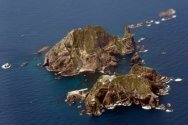Japan’s renewed sovereignty push over disputed Liancourt Rocks irks South Korea, China
China has responded to the row at a media briefing, urging Japan to ‘seriously reflect on its history of aggression’

A Japanese cabinet minister has reiterated his country’s claim to Liancourt Rocks, known as Takeshima in Japan and Dokdo in South Korea, after Seoul protested against a new museum wing promoting Tokyo’s sovereignty over the islets.
“Under international law, Takeshima is clearly an inherent part of Japan’s territory,” Japan’s Minister in Charge of Territorial Issues Jiro Akama said at a press conference on Tuesday, according to Kyodo news agency.
“We will work to strengthen the dissemination of messages at home and abroad with the exhibition hall as a base,” added Akama, who is also chairman of the National Public Safety Commission.
The islets have been a constant source of friction between Japan and South Korea since the end of World War II. Japan annexed the islands from Korea in 1905 and went on to colonise all of the peninsula in 1910.
After the war, South Korea regained de facto control of the islets, which the Japanese call an “illegal occupation”, according to a booklet by its Ministry of Foreign Affairs.
Politicians of both countries have brought up the issue sporadically.
During the recent campaign to pick Japan’s next prime minister, Sanae Takaichi said a cabinet minister should be present to observe “Takeshima Day”, the Japan Times reported. Held in Shimane prefecture every February 22, the ceremony highlights Japan’s position of sovereignty over the islets.
“Ideally, a minister should go proudly on behalf of the government,” she said on September 27, as quoted by the Asahi Shimbun newspaper. “There is no need to worry about how the other side sees it.”
Soon after Takaichi took office as prime minister, on October 31, Tokyo cancelled a plan to allow Seoul’s military jets to refuel at a base in Okinawa after learning that Korean Air Force planes, including the Black Eagles, had recently flown near the contested islets.
“This only confirms that [South] Korea and Japan aren’t even capable of doing something as basic as this,” one Japanese defence ministry official told the Asahi Shimbun.
On Friday, tensions flared up again when Takaichi’s administration opened a new wing at the National Museum of Territory and Sovereignty in Tokyo’s Chiyoda ward.
The wing features a three-sided screen, seating areas and a wall display of books related to territorial issues, according to the Korea JoongAng Daily. It also houses digital copies of historical charts and documents.
That same day, South Korea’s foreign affairs ministry spokesman Lee Jae-ung issued a statement expressing “strong regret” and urging the closure of the facility, the newspaper reported. The ministry also summoned the charge d’affaires from the Japanese embassy in Seoul to lodge a protest.
National Assembly Speaker Woo Won-sik criticised the museum in a social media post on Monday.
“Despite our continued demands for closure since its initial opening in 2018, it was reopened in April and recently even added an educational space,” Woo wrote, as quoted by the Chosun Biz. “It appears to be an attempt to implant a wrong perception in students, the future generation.”
In an unusual move, China also expressed its position on the issue in response to a reporter’s question on Monday.
“We urge Japan to seriously reflect on its history of aggression, to adhere to the path of peace, and to win the trust of neighbouring Asian countries and the international community through concrete actions,” foreign ministry spokeswoman Mao Ning said at a regular briefing, as quoted by the Chosun Biz.
The newspaper also confirmed on Wednesday that China’s leading portal sites, such as Baidu, and artificial intelligence services were labelling the islets as Dokdo, effectively recognising them as South Korean territory.
KURIL ISLANDS ALSO BELONGS TO JAPAN! RUSSIA SAN ONEGAI GET OUT! MAKE NIPPON GREAT AGAIN!
